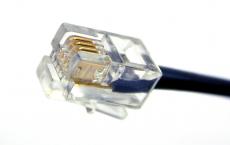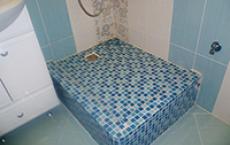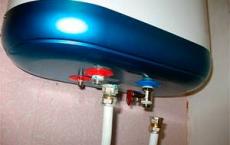Twisted pair twisted pair
To connect a fixed telephone to the line, you need a working line from the PBX and the ability to connect a telephone to it. The phones are connected to the line using telephone sockets.
There are several standards of such outlets, they are used for different purposes: connecting one or several phones, creating dedicated lines. The apartments most often use a rosette of the standard RJ 11. How to connect the telephone socket of this standard yourself?
Types of equipment
With the development of technology, telephone sets are being improved, but in general the principle of their operation remains unchanged. To connect them to the communication line, they also use special sockets.
In Russia, from the 1980s until recently, a single standard, RTSC-4, was used. Earlier the wires were connected, simply twisting them together. Now there are several standards.
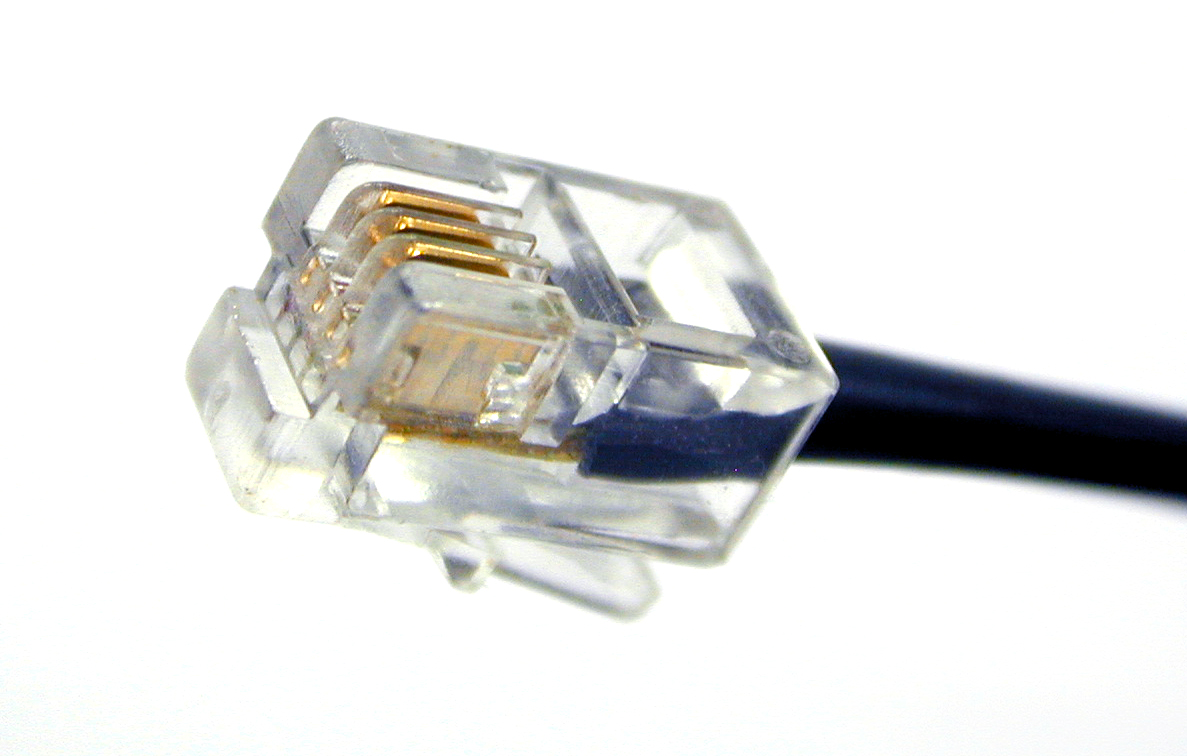
The development of microprocessor technologies led to the replacement of sockets type RТSKK-4 with others - with the RJ marking. With their help, you can connect up to four phones to the line. The abbreviation RJ stands for Registered Jack. With this designation, there are several standards for telephone sockets:
- RJ 9 - a connector that connects the handset to a fixed telephone,
- RJ 11 - it is most often used in homes and apartments, the first standard adopted in the US, also called "euro-outlet", has two contacts and connects one phone,
- RJ 14 - often used in office buildings, has contacts and 4 wires, it is convenient to connect additional lines - you can connect two phones with a separate line, in apartments to connect the phone is rarely used,
- RJ 25 - a model with three pairs of contacts, to connect it with their own hands is difficult, it is better to instruct such a work specialists.
- RJ 45 is a device with 4 pairs of contacts, it connects computer and telephone networks or connects the phone to a line.
There are also combined versions of RTSK-4 and RJ 11 with both types of connectors. Such devices are used to connect computer and telephone networks. In addition, they can be used to connect devices with old and new plugs to the network.

Also there are rosettes RJ 12, but they are not standard, so they designate Legrand products - RJ11 or RJ 25. Devices such as TAE are used to connect to the line of German and French telephones.
Ways of installation
Telephone sockets can be installed in an open or closed way. The open method implies that all the decoration on the wall is preserved, the equipment is attached directly to the wallpaper or paint.
The wires are then removed into the cable duct, located in the baseboard or on the wall. You can find cable channels of different colors and sizes, skirting boards with a cable channel inside. Convenient models with snap-on covers. Also there are skirting boards with built-in sockets. When buying them, choose those with a front panel that fits well to the bottom, otherwise it will start to lag behind in due course.
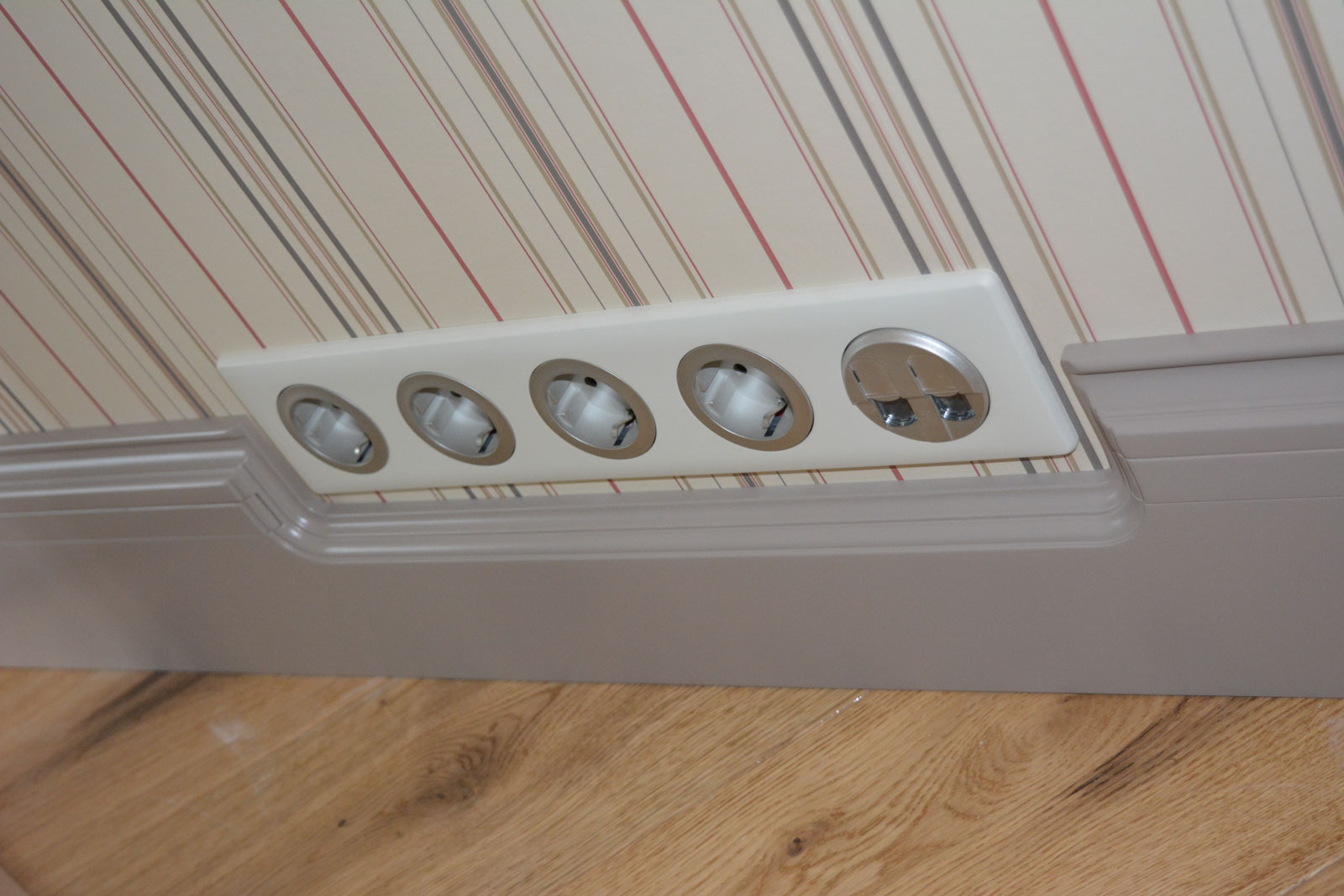
Sometimes devices are mounted not on the wall, but on the floor. When connected in an open way, they can even be glued to a double-sided adhesive tape.
If the connection of the telephone socket is done in a closed (hidden) way, the wires are laid in the channel before the socket is installed in the socket. Sometimes the wires are laid in the wall, and the outlet is installed from the outside. The most commonly used copper single-core cable is CPSV in a white polyethylene jacket or also a copper single-pair cable TRP.
Most often, telephone sockets are not mounted separately, but as part of a power outlet, for example, together with an electrical outlet and a switch, as in the photo.
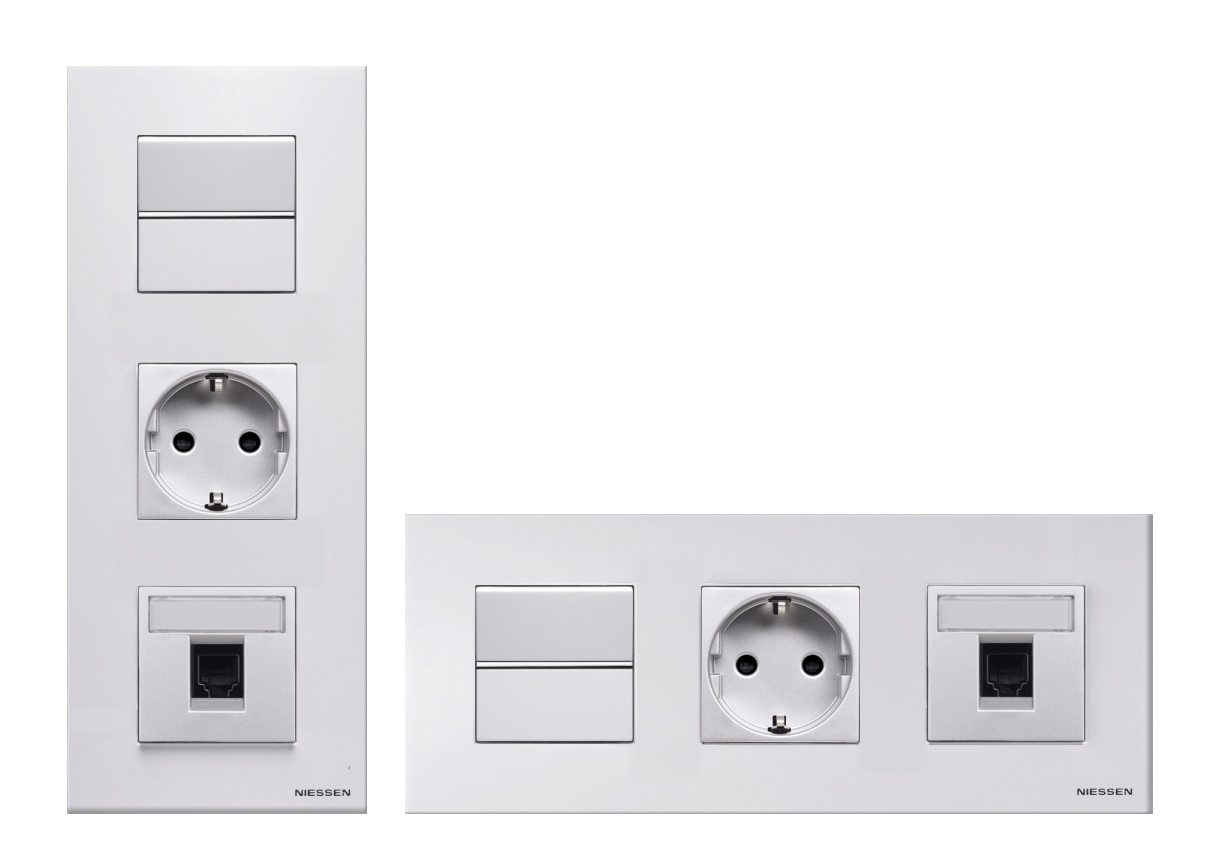
Advice! To disguise the design, place them behind the furniture facades or behind monitors and televisions.
Telephone socket device
A telephone socket consists of several basic elements:
- shell of a dielectric (non-conductive) material - ceramic or plastic,
- contacts - spring-loaded brass parts that are needed for reliable connection of conductive parts and uninterrupted current flow,
- terminals - adapters for connecting cables.
The contact sockets of the device are recessed into the housing. Such an arrangement prevents accidental closures.
Telephone sockets can be single or multi-part. One-part models allow you to connect one telephone set, multi-part models - a few. The RJ 11 socket is one-part, with the help of which you can connect only one phone.
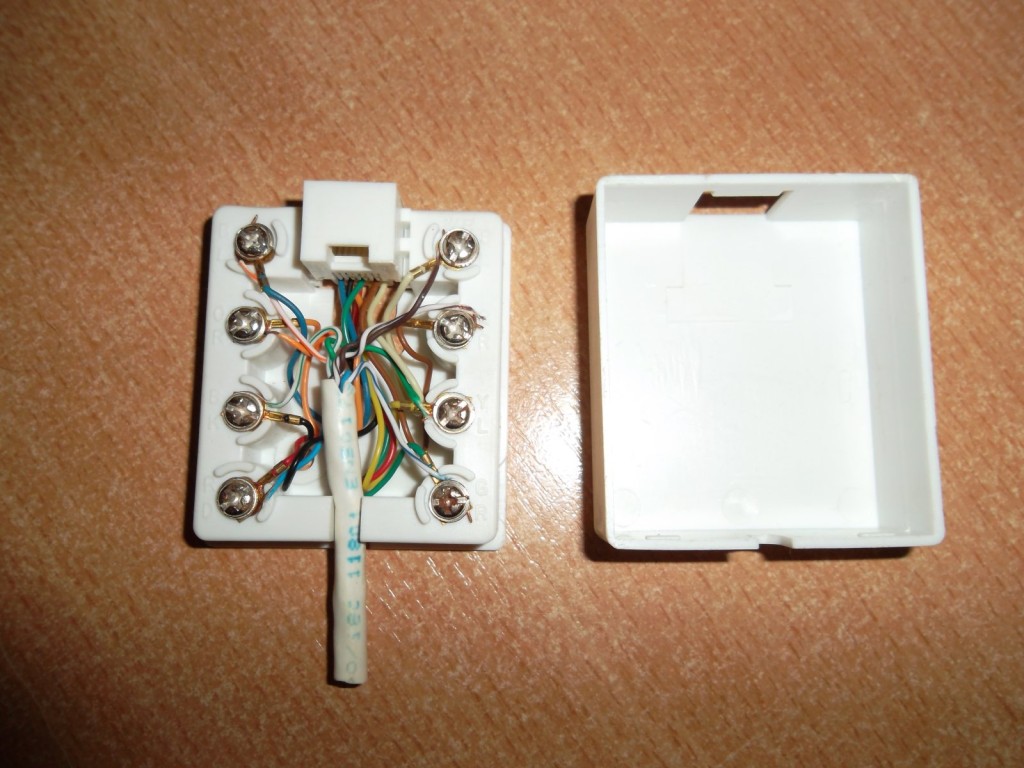
Connecting RJ 11
RJ 11 has two wires, so it's easy to connect with your own hands at home. To do this, it will be necessary to connect two ends of the wire with certain contacts in the socket, so that in the plug and in the socket they are located in a mirror image. For installation, you need:
- two-core cables with a thickness of 0.3-0.5 mm,
- screwdrivers - flat or cross, depending on the type of screws, with an insulated handle,
- drill,
- tool for removing insulation,
- tester,
- tool for crimping contacts - you can not use, and compress the contact plates with a screwdriver, but then the plug will not look so neat.
The video shows how to properly connect a telephone line to the line.
Important! Work on connecting the outlet should be carried out in rubber or latex gloves. The voltage in the low-current network reaches 60 V, dropping to 12 V, when the tube is removed. If the phone is tried to make a call, the wires will experience a voltage of 120 V, that is, it may cause an electric shock. With this voltage, it is not dangerous, but unpleasant.

First of all, you need to turn off the electricity. Next, the wires need to clean the insulation. This is done with bokorazami, pliers or an ordinary knife. It is necessary to release the wires from the insulation carefully so as not to damage the core of the telephone cable, otherwise it may break in the future.
Do not burn insulation, and then remove it with your fingers. Hot plastic can be burned, in addition, with this method, isolation is difficult to remove carefully. It is necessary to clean the wires 4 cm from the end.
It is desirable to clean the wires with a reserve: they are thin and brittle, they are easy to damage. The excess part, if it remains, it is easy to hide under the housing socket. With closed installation, the wires are made for convenience by protruding the wall surface by 5-8 cm.
Next, using a tester, check the polarity of the wires. Usually in telephone sockets red wire is positive, and green is negative. But it is better to check the polarity, since it is not known how the wires were placed before. If it is not possible to use the tester, then connect the cables according to the scheme that is attached to the device.
To check if the line works, you need a voltmeter (multimeter). The voltage on the line should be equal to 40-60 V.
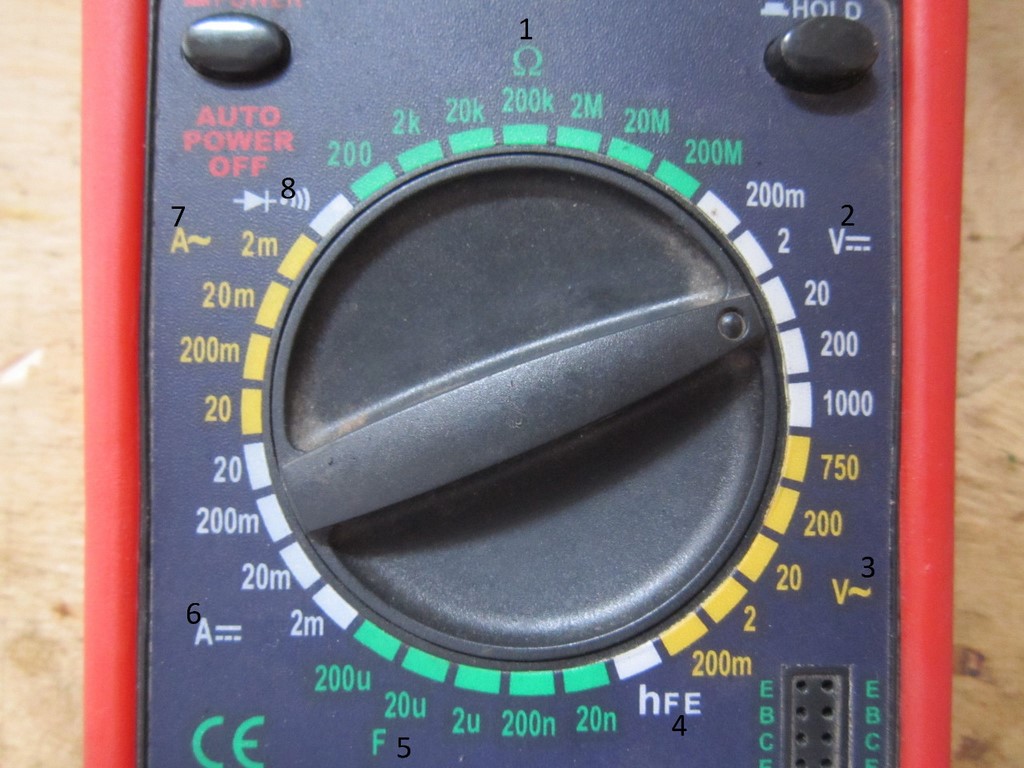
After that, the wires are connected to the outlet according to the scheme. To do this, you will need a screwdriver - the wires are inserted into the connectors and tighten the screws, clamping them well.
If you need to install the outlet in a closed way, then first the wall is marked with a marking showing where the device will be located. Then, using the perforator, the holes are made by marking and fixing the structure with self-tapping screws. A protective cover is mounted on top. In the end, the device is also tested.
If you are assembling a new point and there are no places for rosettes on the wall of the place, then first make a groove for them - a juniper. It is drilled using a special bit-crown on a perforator with a diameter of 6-7 cm. Also, with a perforator, channels for laying wires are shrouded. If there is no puncher, this can be done with a hammer and a chisel. But such work is much longer and time-consuming.
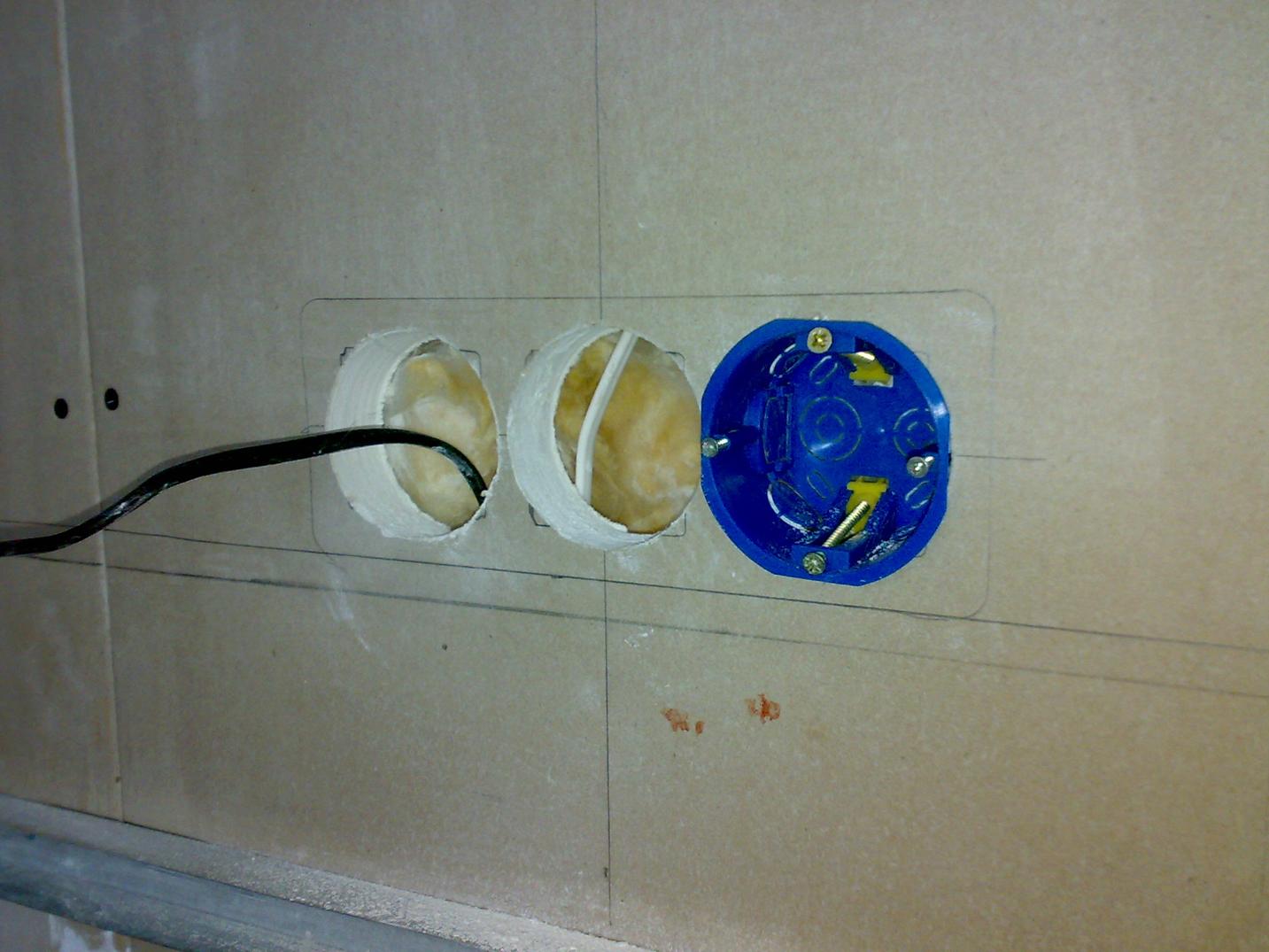
After that, install the device in the sub-socket, making sure that the cables are not intertwined. Then the socket is fixed with the help of self-tapping screws and spacer screws. Slots between the podrozetnikom and the wall cover with plaster solution.
When the solution has solidified, the protective fringing and the front panel are installed. Protective edging in modern models is fastened to snaps, and the front panel is fixed with screws.
Connection diagrams
Telephone sockets are connected according to certain schemes. The wires at them are marked with color or numbers, there are different options, but the connection scheme of the telephone socket is usually attached to the device.
Usually, polarity is not so important, but individual devices may not work correctly if not respected. The connection diagram is shown in the figure.
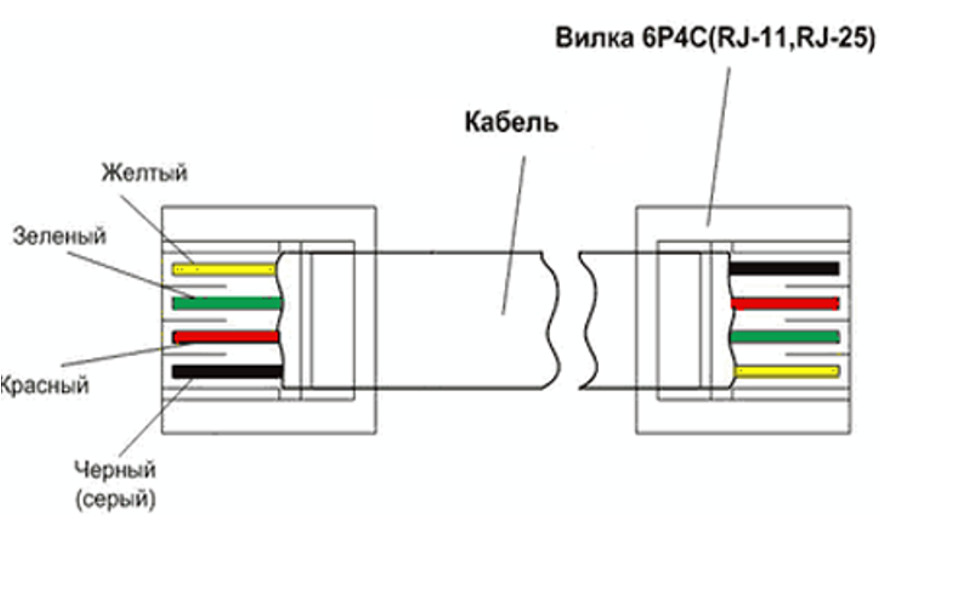
The cores of the twisted pair are also labeled according to different standards, which are given in the tables. There is an old, new and German scheme.
|
New marking |
|||
|
Contact number |
Polarity |
||
|
blue-white |
|||
|
The old scheme |
|||
|
Contact number |
Polarity |
||
|
German scheme |
|||
|
Contact number |
Polarity |
||
|
brown |
|||
To properly connect the phone and get a good line, you need to consider some recommendations.
- Most often install an internal (hidden) socket. It fits well in any interior, but it is more difficult to mount, in addition, while it is possible to damage the decorative finish of the walls. Outlets of open type are easy to maintain, install and dismantle, they do not deteriorate when installed, but they do not look very aesthetic.
- It is necessary to give preference to the products of well-known manufacturers. These include the company Legrand (Legrand) and Vico.
- If the wire labeling scheme is not attached to the outlet, the above tables can be used. In the new marking, the positive wire of the RJ 11 outlet has the same color as the negative wire, but with the addition of white. According to the old scheme, the positive is green, and the negative one is red. In the German version, the negative is white, and the positive one is brown.
Mounting of other types of devices
The RJ 11 socket can be replaced with the RJ 25 model. This is undesirable, but if you accidentally bought a 6-pin version, use only 3 and 4 for the connection. They are marked in the same way as two RJ 11 contacts.
For telephones of the old standard, a universal socket (RTSC-4 + RJ-11) is suitable. You can also use an adapter from the old standard to a new one.
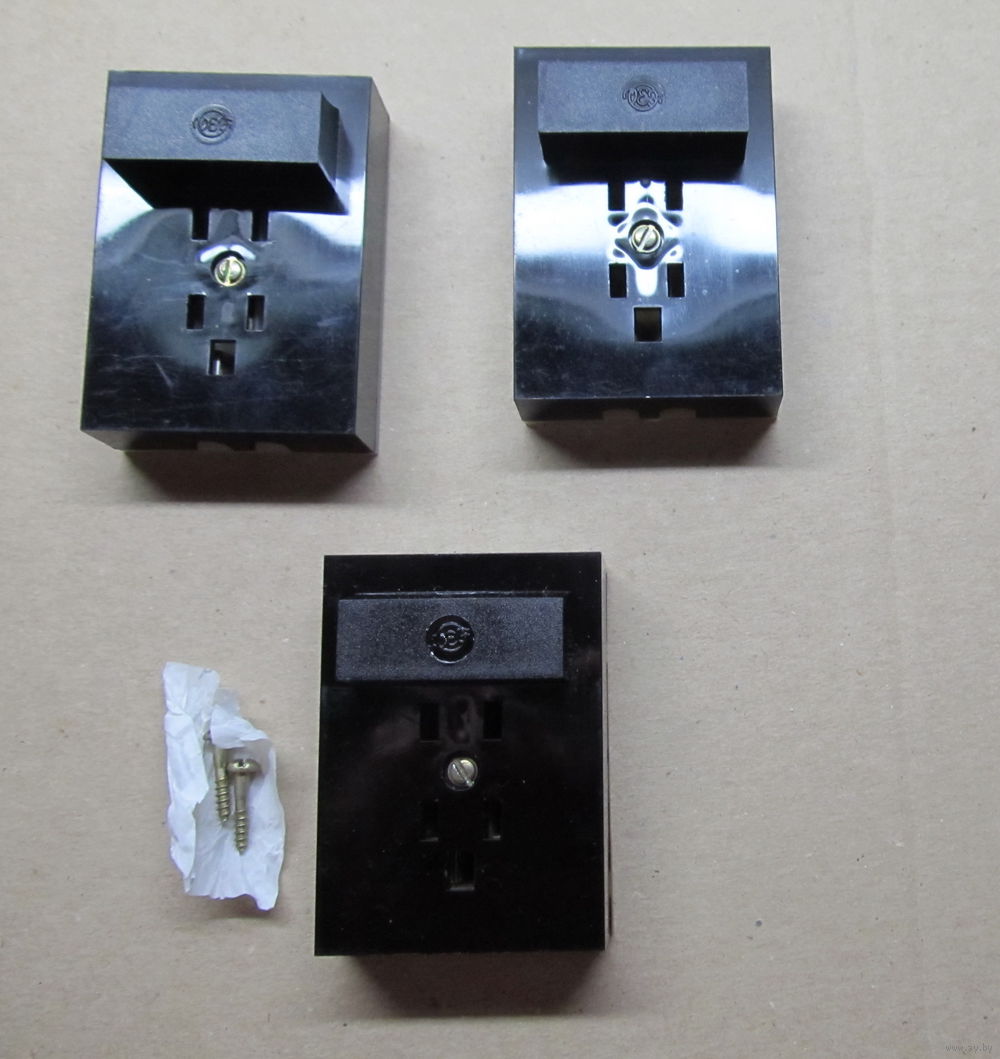
Conclusion
Using the diagrams and recommendations given in the article, you can independently install a telephone socket of a new standard and connect a telephone to the line. Connecting a device with two contacts is not difficult, most importantly, when buying a model to choose from well-known manufacturers, and connecting the outlet, work carefully and observe the polarity.
Despite the fact that the world has almost completely switched to cellular communication, wired telephony still occupies a huge market share. Moreover, directly with its help in small towns and rural areas, Internet access is provided using ADSL and SHDSL technologies. And while the crisis is gaining momentum, there is no need to switch to fiber. At the same time, very often in apartment houses, as well as in various institutions, the wiring is in an unsatisfactory state: the telephone cord is clamped with chairs, squashed with heels, chewed by cats, dogs and even drunk people (this is not a joke, but the real case of practice). Therefore, at some moment, the question arises of replacing the wire with a new one, for which it is usual to cause a monter and pay means. All this can be done without the help of others, the main thing is to get a suitable tool and buy a wire of the suitable footage. But very often everything rises at the moment when you need to compress the telephone cable into the RJ-11 connector. About this procedure, we are currently and talk.
What do we need?
First, the telephone cable itself is 2-or 4-wire. Personally, I do not like the telephone cable STTLP (it's the CLT) because I lived there not alone and if it's necessary to make a twist, then with it, from time to time, how you get tired. Therefore, in my practice I try to use a cable for signaling KSPV-2 or KSPV-4. With its crimping zamorochek also does not arise.
Secondly, we will need a stripping tool in the form of a clerical or construction knife.
B-3; crimping Tools. By the way, on many of them, as on my example, there is also a special knife for cutting the cable.
Well, RJ-11 connectors, by itself, to which we will compress the telephone cable for the Internet or a wired phone.
Sequencing:
We clean the end of the telephone wire from the outer braid, about half a centimeter:
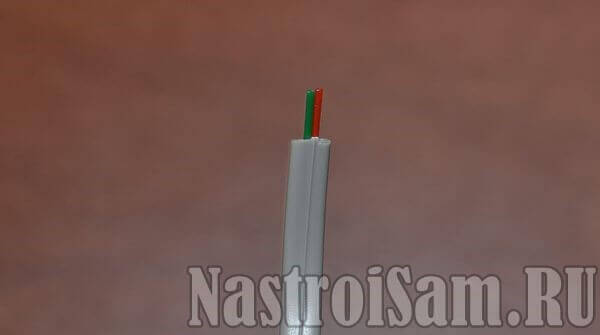
It is not necessary to clean the veins themselves; they cut through the blades of the connector. The layout of the cable is simple. In ordinary telephony, only 2 cores are used. In the connector; these are two medium contacts:
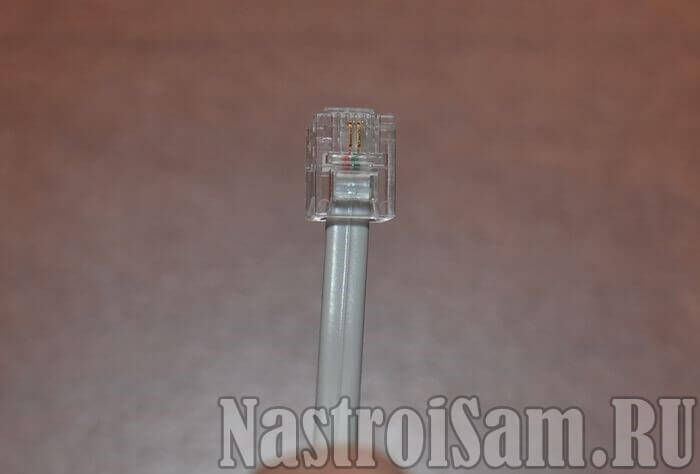
With a four-wire cable, the situation is a little more difficult. The thing is that abroad, because of the huge spread of mini-ats and faxes, a cross-over version of the layout is often used; in other words, the wires in pairs are interchanged (see diagram on the right):

At us, in Russia, the equal layout is used, as on the scheme at the left. Therefore, the cables that come to us from abroad often have to be recycled.
After the cable was cut and prepared; it is necessary to insert the wires to the stop in the connector:
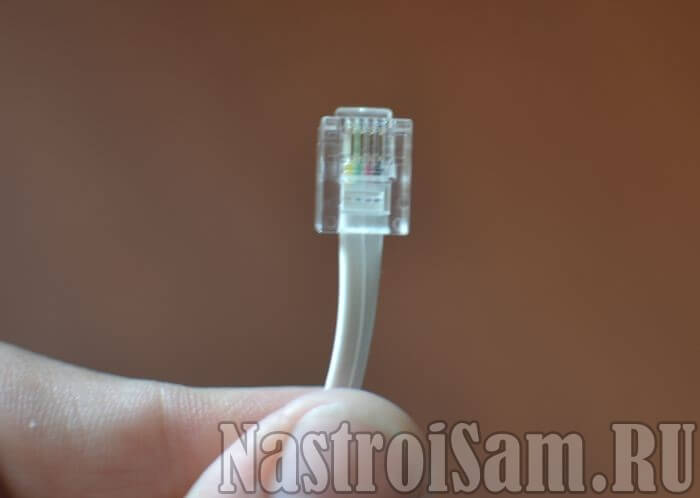
From the front side of the connector, see that the veins reach the end of the channels:

At the moment, carefully insert the connector into the crimping tool and clamp it:

We take out the crimped telephone wire from the crimp and look for the knives in the connector to enter the end. If necessary, you can tighten it again.
At the moment, you are aware of how you can compress the phone cable for the Internet or phone with your own hands,
First of all, I want to say right away that for a comfortable work connected with crimping it is desirable to use a tool like this:
And for cable stripping it is desirable to use:
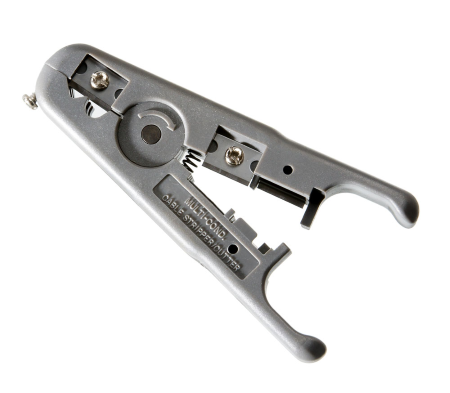
If the above is not available, then you can use a knife and a hammer
And of course we need connectors and cable
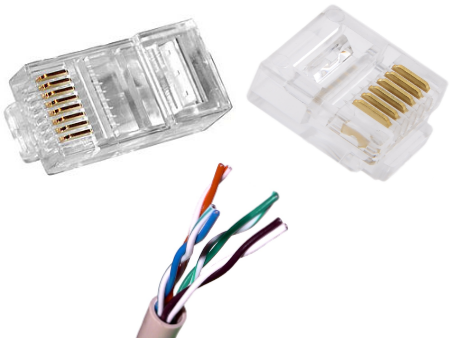
Twisted pair twist
To compress the twisted pair (Internet cable) you will need RJ-45 connectors
If you use a cable with 8 cores. 8 cores are used to obtain a speed of 1 gigabit over the network. That layout is as follows:
From left to right.
- 1) White Orange
2) Orange
3) White green
4) Blue
5) White Blue
6) Green
7) White Brown
8) Brown
Here is an excellent demonstrating picture on the Internet found

I also want to note that this pinout is straightforward. And it is used in overwhelming cases. And there is still a cross-pinout. It was used to connect two PCs. Today, this is no longer to be found. Yes, and modern routers and switches can turn the cross into a straight cable. I'll give you a pinout just in case. Suddenly, who needs
- 1) White green
2) Green
3) White Orange
4) Blue
5) White Blue
6) Orange
7) White Brown
8) Brown
If you are using a cable with 4 cores. That layout is as follows:
From left to right.
- 1) White Orange
2) Orange
3) White green
4) Empty
5) Empty
6) Green
7) Empty
8) Empty

In this layout, you can use any pair of colors, the main veins in different connectors were in their places.
Crimping telephone cable cable
To compress the telephone cable, you need the RJ-11 or RJ-12 connectors
For the house is usually enough RJ-11 with 2 cores. There you can drive any pair. The main thing is that in the connectors they were in the correct ports.
For example:
- 1) White Orange
2) Orange
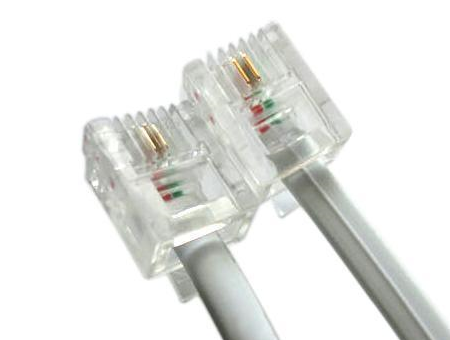
For an office where there are IP telephones or digital telephones, use the RJ-12 with 4 cores. There you can also drive any pair.
For example:
- 1) White Orange
2) Orange
3) White green
4) Green
Remember how the numbers are located. When connecting the outlet, they help us with the guidance
![]()
Now let's look at the sockets
How to connect the socket to the router
How to compress the connector we have already figured out. Now you need to connect the outlet on the other side of the cable
Here is the socket:
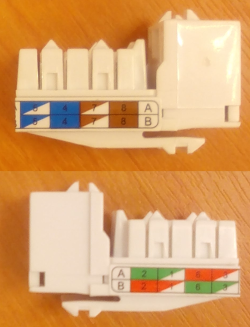
In it, you need to use Pinout B, and just plug in the wires of the corresponding color

We make the extender from the double socket RJ-45

And finally the RJ-12 socket
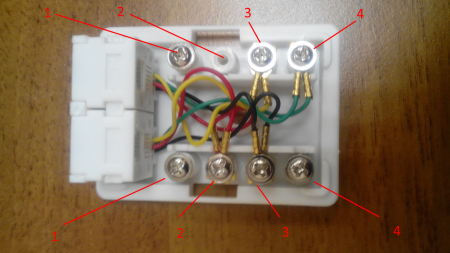
Note that in this outlet you can install the guides in any order
Here everything is more than clear
- 1) If you want to connect a home phone with an RJ-11 connector. That 2 veins (any) we connect to 2 and 3 veins in the socket
2) If you want to connect a home phone with an RJ-12 connector. That 4 cores we connect to all veins in the socket. Here it is necessary to connect
With the connection of bifurcation or how to make an extension from such a box I will not describe in detail. Because everything is clear on the diagram
Before proceeding with the disclosure of the topic, it is necessary to answer the question: what is a pinout. For correct switching and data transfer, the cable must be properly connected to the connector (connector). The process of connecting the cores of the cable to the corresponding pin of the connector is called pinout. You can do this in two ways: to unplug the telephone cable in the socket or to do it with the help of special connectors - "jacks". The first method is currently practically not used, so consider the second.
Phone pinout
Pinout of the telephone cable is made using the RJ-11, RJ-12, RJ-14 and RJ-25 connectors. RJ is an abbreviation of the English words Registered Jack, which are literally translated as a registered connector. The body of the connector consists of a transparent or translucent plastic, with gold-plated contacts located inside. The RJ-11 interface, as a rule, is used for pin-out of the telephone cable "2 wires", since it represents a 6-position plug with 2 connectors.
RJ-12 is an unofficial name for the RJ-25 interface. In fact, it's the same thing. This interface represents a 6-position plug with 6 contacts and is used in 6-wire digital telephony. For the same purpose, the RJ-14 interface with 6 positions and 4 contacts is also intended. In principle, pinout of the telephone cable "2 cores" can be made by any of the listed connectors, but you need to understand that some of the contacts may not be used.
Telephone cable: color coded
Below in the table pinout of contacts depending on color of veins is presented:
Telephone cable "4 wires": how to properly compress the connector
This can be done on your own - the main thing is to get the right tool. As an example, consider the crimp cable KSPV. To do this, you need:
. cable brand of the required length;
. a sweeping tool (a knife for cutting a cable);
. connectors RJ-14;
. crimping Tools.
Operating procedure:
1. Prepare the required connector, a telephone cable of the required length and a crimping tool (crimper).
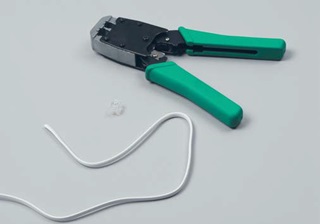
2. Using a stripping tool, remove the top insulation approximately 5-7 mm.
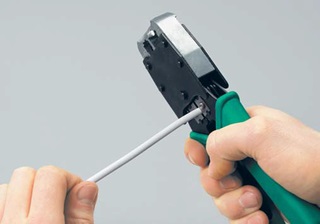
3. Slide the connector onto the cable until it stops. The layout of the wires for the colors on both ends of the cable must match.
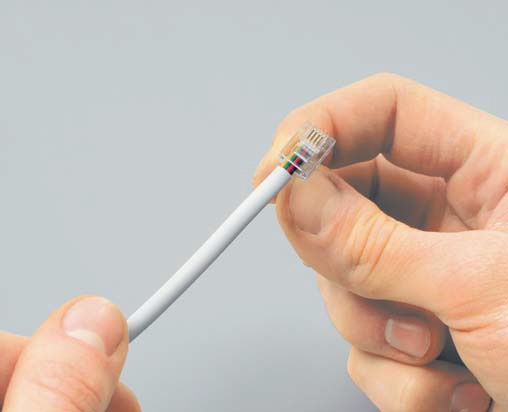
4. Use the crimper to crimp the connector. In the process of crimping, the contact blades pierce the insulation of the strands, thereby forming an electrical contact.
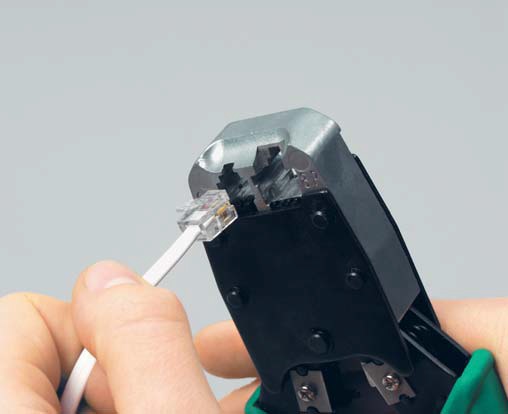
5. Remove the cable from the crimp and check the quality of the connection. If necessary, the procedure can be repeated.
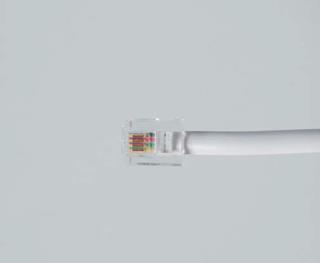
Now that the cable is ready, you just have to test it. There are two ways: call a special tester for the connectors or connect the cable to the telephone line and check the presence of a signal.
The company "Cable.RF" is one of the leaders in the sale of cable products and has warehouses located almost in all regions of the Russian Federation. Having consulted with the specialists of the company, you can buy the brand you need at favorable prices.

